Pilot Information
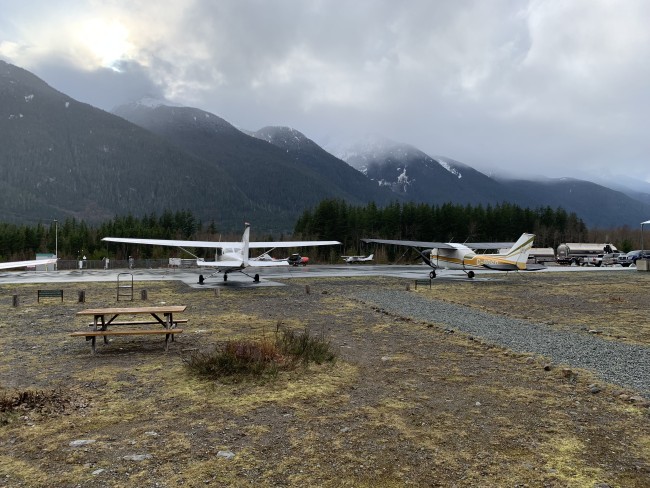
The Canada Flight Supplement ("CFS") is published by NAV CANADA on a 56-day cycle and includes a comprehensive directory of all registered aerodromes and certified airports, including information such as airfield diagrams, services available, and facility-specific procedures. Except where noted through a reference to an enabling section of the Canadian Aviation Regulations, airport information published in the CFS is for reference only and is not a regulatory standard.
The following provisions will be added to the CFS through the December 29, 2022 publication cycle and are currently published through a Notice to Airmen (NOTAM) effective August 11, 2022:
-
- CIRCUIT TRNG NOT AUTH 04-16Z (DT 03-15Z) PPR
- ITINERANT ACFT CIRCUIT TRNG PPR
The intent of these new provisions is to limit the potential disturbance to nearby residents caused by circuit training during the morning and evening hours, as well as by itinerant aircraft not based at Squamish Municipal Airport. The District requests that pilots familiarize themselves with these new provisions and adhere to them.
The CFS entry for the Airport includes a diagram titled the Squamish VFR Terminal Procedures Chart (VTPC) and provides recommended flightpaths for aircraft operating under Visual Flight Rules (VFR) at the Airport – the VTPC is a set of guidelines as opposed to a set of regulatory standards enforceable pursuant to the Canadian Aviation Regulations. The intent of the VTPC is to route aircraft in a manner that will reduce overflights to noise sensitive residential areas.
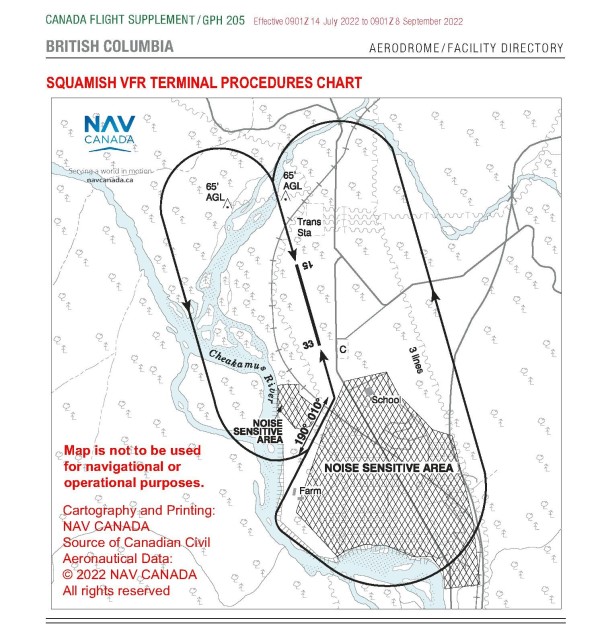
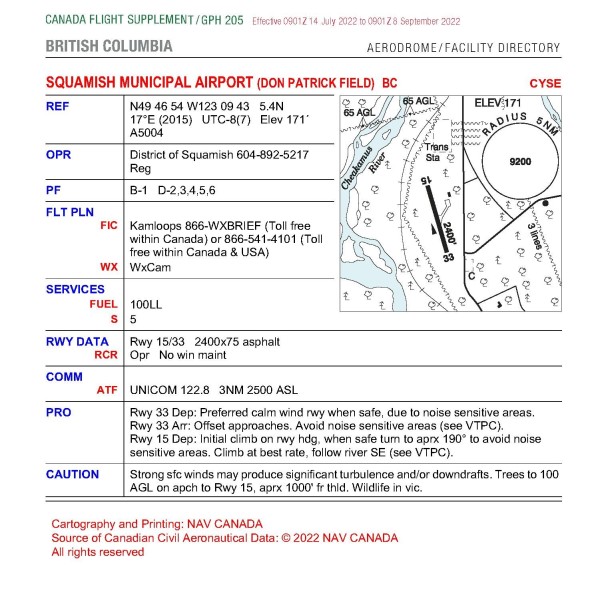
The District does not own or operate aircraft fueling facilities. Four tenants of the Airport operate fuel systems on an independent basis:
- The Squamish Flying Club maintains an above-ground 100 Low Lead (“avgas”) self-service fuelling facility adjacent to the apron, which is available 24 hours per day through a payment kiosk collocated with their clubhouse;
- Glacier Air operates an above-ground avgas facility for use by its fleet;
- Blackcomb Helicopters maintains above-ground Jet A (“jet fuel”) fuel facilities for its fleet, and also sells jet fuel to itinerant operators; and
- Black Tusk Helicopter operates above-ground jet fuel facilities.
Runway 15-33
Runway 15-33 is a 2,400 ft. x 75 ft. (732 m x 23 m) paved facility that is used for fixed-wing and rotary- wing arrivals and departures. Runway 15-33 was rehabilitated in 2021 through funding provided by the British Columbia Air Access Program and was observed to be in very good condition by HM Aero in March 2022. Based on TP312 5th Edition, the width of Runway 15-33 permits operations by fixed-wing aircraft with outer main gear wheel spans of up to 6.0 m. This is adequate for the full range of single and twin-engine aircraft that typically operate at the Airport.
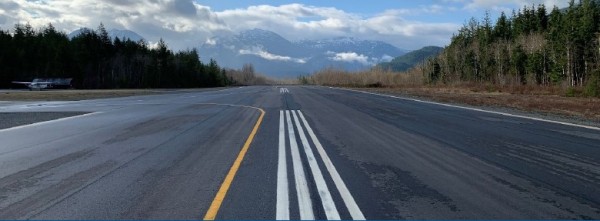
Runway 15-33 at the intersection with Taxiway A
Taxiways
Taxiway A is a 9 m (30 ft.) wide paved facility that connects the apron with Runway 15-33. Taxiway A was rehabilitated in 2015 through funding provided by the British Columbia Air Access Program and was observed to be in very good condition in March 2022. The width of Taxiway A meets the TP312 standards for aircraft with a maximum outer main gear wheel span of up to 4.5 m and is adequate for the regular users requiring access to the apron.
Secondary taxiways connect the Squamish Flying Club hangars with the apron, Blackcomb Helicopters’ fuelling area with Runway 15-33, and Glacier Air’s apron with Runway 15-33.
Visual Navigation Aids
A Wind Direction Indicator of a conspicuous size and colour is located at the intersection of Runway 15-33 and Taxiway A in compliance with the Airport’s obligations per the CARs. Three signs have been installed on the airfield, including a mandatory instruction sign at the Taxiway A holding position and noise mitigation information signs installed adjacent to Taxiway A and the Runway 15 threshold. Lighting is not provided to support aircraft operations during hours of darkness.
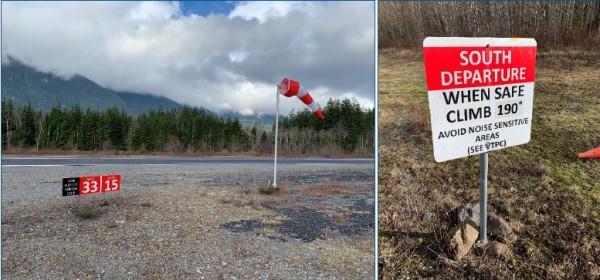
Instruction Sign and Wind Direction Indicator (left) and Runway 15 Noise Mitigation Information Sign (right)
Apron
The aircraft parking apron consists of a 70 m x 50 m paved area, 50 m x 40 m gravel area to the west, and additional gravel areas adjacent to the south and west.

Taxiway A (left) and Apron (right)
Squamish Airport is an uncontrolled facility, and NAV CANADA does not maintain an Air Traffic Control Tower, Flight Service Station, or other similar facilities at the Airport. Aircraft are responsible for communicating their intentions and coordinating with other operators to ensure safety. An Aerodrome Traffic Frequency (ATF) is established through the CFS for use by aircraft operating at, and in the vicinity of, the Airport.
The District, tenants and businesses, and aircraft operators do not have the authority to issue instructions or clearances to aircraft operating at the Airport. While information can be provided between pilots on the ATF to support safe operations, pilots ultimately have decision-making authority to ensure the safety of their flight.
The District is not involved in maintaining hangars for use by itinerant or based aircraft. The Squamish Flying Club maintains two hangars with a combined total of 19 bays for long-term rent. Glacier Air, Blackcomb Helicopters, and Black Tusk Helicopter each maintain hangar facilities on their leasehold lots for their aircraft fleets.
Instrument Flight Procedures are not published to support arrivals and departures during Instrument Meteorological Conditions. Aircraft operating at the Airport do so under Visual Flight Rules only, meaning that minimum visibility and cloud conditions must be met (Visual Meteorological Conditions), and pilots are able to operate with visual reference to the surface.
There are three (3) fixed wing itinerant parking stalls located along the South side of the apron marked "itinerant parking". These spots are first come first serve and are regulated by the following:
All operators of aircraft using the Airport not in possession of a licence of occupation or lease agreement executed by the District (“itinerant Aircraft”) shall park their aircraft in a location identified by the District for itinerant fixed-wing or rotary-wing parking;
a) pay the Tie Down Accommodation Fees for the use of the Airport, established by the District pursuant to the District of Squamish Fees and Charges Bylaw No. 2012, 2007, as amended and /or replaced from time to time; and (the current tie-down fee is $10/day)
b) secure their aircraft to prevent movement and damage.
Except with the permission of the District, no person shall park an itinerant Aircraft in an itinerant parking location for a period exceeding seventy-two (72) consecutive hours, or eighty (80) hours in a period of fourteen (14) consecutive days.
